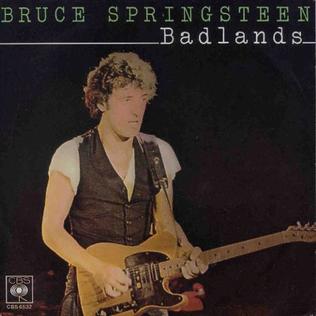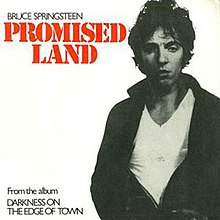
Bruce Frederick Joseph Springsteen is an American rock singer, songwriter, and guitarist. Nicknamed "the Boss", he has released 21 studio albums during a career spanning six decades, most of which feature his backing band, the E Street Band. Springsteen is a pioneer of heartland rock, combining a commercially successful rock sound with poetic and socially conscious lyrics reflecting the issues of working class American life. He is known for his descriptive lyrics and energetic concerts, which sometimes last over four hours.

Born in the U.S.A. is the seventh studio album by the American singer-songwriter Bruce Springsteen, released on June 4, 1984, by Columbia Records. Produced by Springsteen, Jon Landau, Steven Van Zandt, and Chuck Plotkin, the album was recorded in New York City with the E Street Band over two years between January 1982 and March 1984. Some of the songs originated from the same demo tape that yielded Springsteen's previous album, the solo effort Nebraska (1982), while others were written after that album's release. The sessions yielded between 70 and 90 songs; some were released as B-sides, some later saw release on compilation albums, while others remain unreleased.

Darkness on the Edge of Town is the fourth studio album by the American singer-songwriter Bruce Springsteen, released on June 2, 1978, by Columbia Records. The album was recorded after a series of legal disputes between Springsteen and his former manager Mike Appel, during sessions in New York City with the E Street Band from June 1977 to March 1978. Springsteen and Jon Landau served as producers, with assistance from bandmate Steven Van Zandt.

Born to Run is the third studio album by the American singer-songwriter Bruce Springsteen, released on August 25, 1975, by Columbia Records. Co-produced by Springsteen with his manager Mike Appel and the producer Jon Landau, its recording took place in New York. The album marked Springsteen's effort to break into the mainstream following the commercial failures of his first two albums. Springsteen sought to emulate Phil Spector's Wall of Sound production, leading to prolonged sessions with the E Street Band lasting from January 1974 to July 1975; six months alone were spent working on the title track.

The River is the fifth studio album by the American singer-songwriter Bruce Springsteen, released as a double album on October 17, 1980, by Columbia Records. The album was Springsteen's attempt at making a record that captured the E Street Band's live sound. Co-produced by Springsteen, his manager Jon Landau, and bandmate Steven Van Zandt, the recording sessions lasted 18 months in New York City from March 1979 to August 1980. Springsteen originally planned to release a single LP, The Ties That Bind, in late 1979, before deciding it did not fit his vision and scrapped it. Over 50 songs were recorded; outtakes saw release as B-sides and later on compilation albums.

"Tenth Avenue Freeze-Out" is a song by the American singer-songwriter Bruce Springsteen, from his 1975 album Born to Run.

"Prove It All Night" is a song by the American singer-songwriter Bruce Springsteen, released on May 23, 1978, as the first single from his fourth studio album Darkness on the Edge of Town.

"Badlands" is a song by the American singer-songwriter Bruce Springsteen, released as the second single from his fourth studio album Darkness on the Edge of Town in July 1978.
"Darlington County" is a 1984 song written and performed by Bruce Springsteen. It was released on the album Born in the U.S.A. and has remained a popular concert song for Springsteen and the E Street Band.
"The Ties That Bind" is a song written and performed by Bruce Springsteen. It is the opening song on his fifth album, The River. It was the second song recorded for 'The River', at The Power Station in New York on April 9–11, 1979. The recording engineer was Bob Clearmountain. After Springsteen injured himself driving an ATV, forcing a one-month halt, Neil Dorfsman became the chief engineer when sessions resumed. Springsteen wrote the song during September - October 1978, while on the road during the Darkness Tour. After introducing it on November 1, 1978, it was played every night during the final two months of the tour.
"Ramrod" is a song written and performed by Bruce Springsteen for his fifth album, The River, released in 1980. It was recorded at The Power Station in New York on June 12, 1979. The song was written and originally recorded on September 12, 1977, for Springsteen's Darkness on the Edge of Town album, but that recording was not used for its release on The River.
"Night" is a song by Bruce Springsteen which first appeared on the Born to Run album in 1975. Although this is one of the lesser known songs from Born to Run, "Night" has become somewhat of a stage favorite for the E Street Band. The song was not immediately played during the 1975 portions of the Born to Run Tour, but later became a frequent set-opener, especially during the 1976 and 1977 legs. It was still sometimes being used as an opening song decades later during the 2007–2008 Magic Tour.
"Independence Day" is a song written and performed by Bruce Springsteen. It was originally released on his fifth album, The River, in 1980. It was recorded at The Power Station in New York, on April 24–25, 1980.
"Wreck on the Highway" is a song written and performed by Bruce Springsteen. It was originally released as the final track on his fifth album, The River. The version released on The River was recorded at The Power Station in New York in March–April 1980. As well as being the last track on The River, it was the last song recorded for the album.
"Out in the Street" is a song written and performed by Bruce Springsteen from the 1980 album The River. It was recorded at The Power Station in New York between March and May 1980, as one of the last songs recorded for the album. Originally, Springsteen was going to keep the song off the album because it was so idealistic.
"The Angel" is a song by Bruce Springsteen from the album Greetings from Asbury Park, N.J. in 1973. It was also released as the B-side to Springsteen's "Blinded by the Light" single. The song was part of the demo that Springsteen recorded for John Hammond of CBS Records in advance of getting his first recording contract. At the time Greetings from Asbury Park, N.J. was released, Springsteen considered it his most sophisticated song. It has had very few live performances.
"Adam Raised a Cain" is the second track from Bruce Springsteen's fourth album Darkness on the Edge of Town.

"Point Blank" is a song written by Bruce Springsteen and first released on Springsteen's 1980 album The River. In Europe, it was also released as a single in 1981, backed by another song from The River, "Ramrod". Although it was not released as a single in the US, it did reach #20 on the Billboard Mainstream Rock Tracks chart.

"Sherry Darling" is a song by American singer-songwriter Bruce Springsteen from his fifth studio album The River. Originally written for his previous album, 1978's Darkness on the Edge of Town, the song was rejected for not fitting that album's somber tone. The song's frat crowd noises were meant to evoke early rock and roll songs like "Louie, Louie," which similarly had loud incidental crowd noises.
"Darkness on the Edge of Town" is the last song on the 1978 album of the same name, Darkness on the Edge of Town, by Bruce Springsteen. It was the last song recorded and mixed, and in April 1978 it was designated the title song to a thematic album whose songs portray the struggles of the less-fortunate, not only to survive, but to keep their spirit and will to live. The title track portrays a hard-luck loser in life who refuses to give up. Springsteen's fourth album, released three years after his 1975 effort Born to Run, was delayed two years because of legal problems with his former manager, Mike Appel. Expectations were high after he took one year to complete the album.









